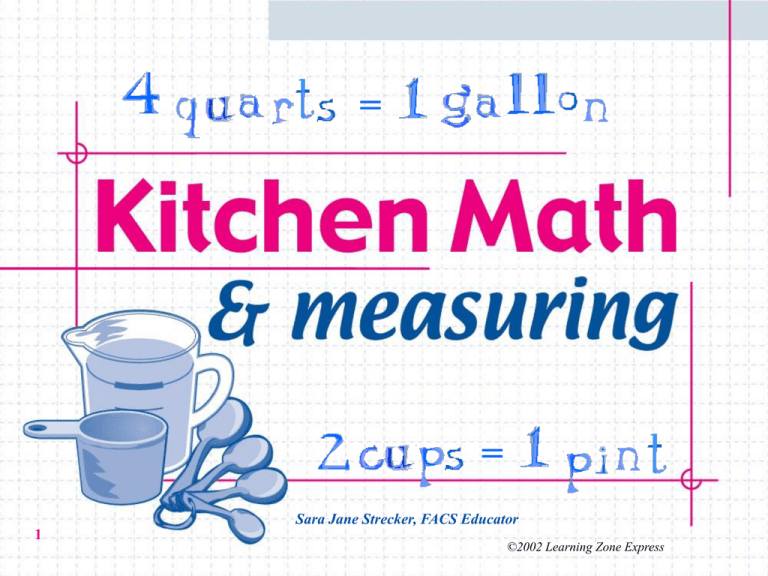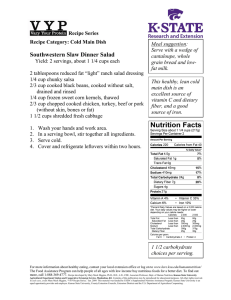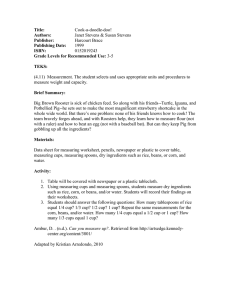Kitchen Math Powerpoint
advertisement

= = 1 Sara Jane Strecker, FACS Educator ©2002 Learning Zone Express Introduction Most cooks use recipes. A recipe is a list of ingredients that gives you directions for preparing a specific food. If you know how to follow recipes, then you will be successful in the kitchen. Who knows! You may become a famous chef! 2 ©2002 Learning Zone Express Introduction Successful cooks know: • How to read a recipe • Abbreviations • Measuring Techniques • Equivalents • How to Change a Recipe 3 ©2002 Learning Zone Express What’s in a recipe? A formula! Read the recipe before you cook. The parts of the recipe tell you: • Name • Ingredients • Equipment • Directions • Yield (number of servings) • Sometimes - Nutritional Analysis 4 ©2002 Learning Zone Express Parts of a Recipe Name What the recipe is called. A recipe usually includes: Quesadillas Yield (Serves 4 - 2 per person) Number of servings the recipe makes. Equipment 8 flour tortillas Ingredients 1 cup grated cheese 1. Heat a frying pan over medium heat. 2. Place a tortilla in the pan. 3. Sprinkle 1/4 cup cheese on the tortilla. 4. Cover the cheese with another tortilla. Directions Steps you follow to make the recipe. 5 5. Cook about 1 minute, until brown and crisp. Then turn the quesadilla over. Cook until the cheese melts. 6. Place on a serving plate. Cut into pie shaped wedges. 7. Repeat process with remaining ingredients. ©2002 Learning Zone Express Food products you need to make the recipe. Your turn Think up a name for a recipe. What is the yield? How many people will it serve? Name each ingredient. Write the steps in the order that you would prepare them. Number each step. How many steps are there? What special equipment is needed? 6 ©2002 Learning Zone Express What’s an Abbreviation? Understanding the language of recipes takes the guesswork out of cooking. Abbreviation - The shortened form of a word. Abbreviations in measuring units: • Save space on the cookbook page. • Make recipes easier to read. 7 ©2002 Learning Zone Express Name the Abbreviations The U.S. uses the English system: • Teaspoon • Tablespoon Tbsp. or T. • Cup c. • Pint pt. • Quart qt. • Gallon gal. • Ounce/fluid ounce • Pound 8 tsp. or t. ©2002 Learning Zone Express oz./ fl. oz. lb. Name the Abbreviations Most other countries use the Metric system: 9 • Milliliter ml • Liter L • Grams g • Kilogram kg ©2002 Learning Zone Express Name the Abbreviations More abbreviations: • • • • • • • Few grains, dash, pinch Dozen Pound Inch Second Minute Hour • Degree • Fahrenheit/Celsius 10 ©2002 Learning Zone Express f.g. doz. lb. in. sec. min. hr. F. / C Abbreviations Pop Quiz What do these stand for? • lb. •L • tsp. or t. • F. • qt. • fl. oz. 11 ©2002 Learning Zone Express Name That Utensil Serving spoons & cups vary in size. Only use these standard measuring utensils… Can you name them? 12 ©2002 Learning Zone Express The Right Measuring Utensil What are two ingredients that you’d measure with when using: • measuring spoons? • dry/solid measuring cups? • a liquid measuring cup? Which measuring utensil would you use to measure each of these ingredients? • • • • 13 1 1/3 cups flour 1 1/2 teaspoons baking powder 1/2 cup milk 2 tablespoons cooking oil ©2002 Learning Zone Express Measuring Liquid Ingredients Liquid ingredients can include: • Milk, water, oil, juice, vanilla extract, etc. To measure 1/4 cup or more of a liquid ingredient, use a clear, liquid measuring cup. • Place the cup on level surface and read measurements at eye level. For smaller amounts use measuring spoons. • Fill the spoon until a slight dome is visible. 14 ©2002 Learning Zone Express Measuring Dry Ingredients A standard set of dry/solid measuring cups is made of four cup sizes. What amount does each cup measure? 15 ©2002 Learning Zone Express Measuring Dry Ingredients Dry ingredients can include: • Flour, sugar, brown sugar, salt, and baking powder. To measure 1/4 cup or more of a dry ingredient use a measuring cup. • Measuring cups generally come in 1/4, 1/3, 1/2, and 1 cup sizes. To measure less than a 1/4 cup use a measuring spoon. 16 • Measuring spoons generally come in 1/4, 1/2, & 1 teaspoon & 1 tablespoon sizes. • To measure 1/8 tsp. measure 1/4 tsp. & then remove half. ©2002 Learning Zone Express Measuring Dry Ingredients Measuring flour: • Do not pack the flour into the measuring cup or spoon because you will end up with more flour. Instead, scoop flour into the cup and level with a spatula or knife. Measuring brown sugar: • Pack the brown sugar tightly into the measuring cup or spoon. Once it is packed down, level it with a straight edge or knife. Measuring granulated sugar: • Fill the cup with sugar. Level with the back of a spatula or knife so that sugar is even with top of measuring cup or spoon. 17 ©2002 Learning Zone Express Pass the Cup Dry/solid measure check-up: • Which of these amounts is greater? Write the amount. 18 1/2 cup or 3/4 cup 1/4 cup or 1/3 cup 1/4 cup or 2 Tbsp. 1/2 cup or 1/4 cup 1/4 cup or 3 tsp. 1 1/3 cup or 1 1/4 cup ©2002 Learning Zone Express Measuring Solid Ingredients Sticks of butter and margarine have measurements marked on the wrapper. • One stick = 1/2 cup or 8 tablespoons Measure solid fats, such as shortening or peanut butter, in a dry measuring cup. • Pack it into the cup and level it with a spatula. Then use a plastic scraper to remove it from the cup. 19 ©2002 Learning Zone Express Measuring Techniques Checklist Can you do these things? 20 3/4 cup sugar 1 cup flour 1 Tbsp. water 1 tsp. salt 1 Tbsp. flour 1 1/3 cups water 1/4 cup brown sugar Ingredients & tools properly cleaned and stored. ©2002 Learning Zone Express Demonstrate proper measuring techniques by completing the checklist. Name:___________________ Checked by:______________ Measuring Just With Spoons This chart shows some amounts that you’ll often see in recipes. And it shows how to measure those amounts with measuring spoons. 21 1 Tbsp. 1 tsp. + 1 tsp. + 1 tsp. 3/4 tsp. 1/4 tsp. + 1/4 tsp. + 1/4 tsp. or 1/2 tsp. + 1/4 tsp. 1/8 tsp. half of 1/4 tsp. 1/8 cup 1 Tbsp. + 1 Tbsp. ©2002 Learning Zone Express Basic Equivalents Equivalents are amounts that are equal to each other. • They are useful when you must alter or change a recipe to serve more or less people than the recipe yields. Dry/Liquid equivalents: 22 • Pinch or Dash • 1 Tablespoon = = less than 1/8 teaspoon 3 teaspoons • 1/4 cup • 1/3 cup • 1/2 cup = = = 4 Tablespoons 5 Tablespoons & 1 teaspoon 8 Tablespoons • 3/4 cup • 1 cup = = 12 Tablespoons 16 Tablespoons ©2002 Learning Zone Express Basic Equivalents To help you remember: 1 Tablespoon = 3 t e a spoons There are 3 letters in the word tea and 3 teaspoons in a tablespoon. 1/4 c. = 4 Tbsp. 23 ©2002 Learning Zone Express Basic Equivalents 1 fluid ounce = 2 Tablespoons 8 ounces = 1 cup 16 ounces = 1 pound 1 pint = 2 cups 1 quart = 2 pints = 4 cups 1 gallon = 4 quarts = 8 pints = 16 cups 24 ©2002 Learning Zone Express Basic Equivalents To help you remember: A formula 2 c. = 1 pt. 2 pt. = 1 qt. 4 qt. = 1 gal. 25 ©2002 Learning Zone Express Equivalents at the Store At the store, many foods are sold by the pint or by the quart. Many recipes will ask you to measure those foods by the cup. Here is a helpful guide: 26 • 1 cup = 1/2 pint • 2 cups = 1 pint • 4 cups = 2 pints • 4 cups = 1 quart • 4 quarts = 1 gallon ©2002 Learning Zone Express Equivalents at the Store Answer the following questions with one of these amounts: 1/2 pint 1 pint 1 quart What size container will you buy if. . . 1. A recipe for salad calls for 2 cups of cottage cheese.? 2. A recipe for a fruit dessert calls for 1 cup of whipping cream? 3. You need 4 cups of milk for a pudding? 4. You need 2 cups of sour cream to make a dip? 5. A recipe for fruit salad says to mix 8 ounces of yogurt with fruit? 27 ©2002 Learning Zone Express Equivalents at the Store Now that you know how many cups make up 1/2 pint, 1 pint, and 1 quart, try to figure out how many ounces are in these amounts: 28 • 1 cup = ___ oz. • 1/2 pint = ___ oz. • 1 pint = ___ oz. • 1 quart = ___ oz. • 1 gallon = ___ oz. ©2002 Learning Zone Express Basic Equivalents Pop Quiz 1. 1. 1 pint = ____ cups 2. 2. 1 gallon = ____ quarts 3. 3. 1 quart = ____ cups 4. 4. 1 cup = ____ tablespoons 5. 5. 1 tablespoon 29 ©2002 Learning Zone Express = ____ teaspoons Putting Cups Together Useful amounts to know: • • • • • • 2/3 cup 3/4 cup 1/8 cup 1 cup 1 cup 1 cup = = = = = = 1/3 cup + 1/3 cup 1/2 cup + 1/4 cup half of 1/4 cup 1/2 cup + 1/2 cup 1/3 cup + 1/3 cup + 1/3 cup 1/4 cup + 1/4 cup + 1/4 cup + 1/4 cup How would you measure these amounts? • 1 1/4 cups • 2/3 cup • 3/4 cup 30 ©2002 Learning Zone Express How Do You Measure Up? This recipe for Chocolate Chip Cookies yields 3 dozen. You need to make 6 dozen. Write down the measurements you would use to double this recipe. Use correct abbreviations. Chocolate Chip Cookies Yields 3 dozen. 2 1/4 cup flour 1 teaspoon baking soda 1/4 teaspoon salt 1 cup margarine 3/4 cup sugar 31 ©2002 Learning Zone Express 3/4 cup brown sugar 1 teaspoon vanilla extract 2 eggs 2 cup chocolate chips How Do You Measure Up? Your Grandma’s recipe for Chocolate Cake makes a large cake so you want to make only half of a cake. Write down the new measurements you would need to make half this recipe. Use correct abbreviations. Chocolate Cake 2 cups sugar 1/2 cup butter 2 eggs 1 cup buttermilk 2 1/2 cups cake flour 32 ©2002 Learning Zone Express 2 teaspoons baking soda 2 chocolate squares 1/2 teaspoon salt 2/3 cup warm water 1 teaspoon vanilla extract How Do You Measure Up? BONUS What is half of 2/3 cup? If a recipe calls for one egg and you want to cut the recipe in half, how might you half an egg? Answer: 1 large egg = 1/4 cup. Crack egg into bowl and mix with fork. Pour out approximately 1/2 or 2 tablespoons of egg. 33 ©2002 Learning Zone Express You’re the Expert Jenny is throwing a surprise birthday party for her best friend Katie. She has decided to make Katie’s favorite dish, meat loaf. There will be a total of 40 people at the party. Answer the following questions: • The recipe says it serves 8 people. By what number should Jenny multiply each ingredient to make enough meat loaf for everyone? • The recipe calls for 1 1/2 lbs. of ground beef. How much ground beef will Jenny need to make enough meat loaf for everyone? • Jenny will be serving milk with the meal. She plans on using 8 oz. glasses. How many gallons of milk does she need to make sure everyone gets one glass of milk? 34 ©2002 Learning Zone Express Kitchen Math Quiz Write down the answers to the following questions. 1. 1 tablespoon is equivalent to __ teaspoons and 1 fluid ounce is equivalent to __ tablespoons. a. b. c. d. 2. 3, 4 4, 1 3, 2 2, 3 How would you measure the following amounts? a. b. c. d. 35 a. b. c. d. a. b. c. d. 2/3 cup 1/8 cup 1 2/3 cup 2 3/4 cups ©2002 Learning Zone Express Kitchen Math Quiz 3. The number of servings a recipe makes is called its ________. a. b. c. d. 4. serving size yield equivalent supply Match the term on the left with the appropriate abbreviation on the right. 1. 2. 3. 4. 5. 36 a. b. c. d. 1. 2. 3. 4. 5. pounds cups tablespoons teaspoons ounces ©2002 Learning Zone Express a. b. c. d. e. c. Tbsp. lb. tsp. oz. Kitchen Math Quiz 5. True of False? a. a. Liquids should always be measured at eye level. b. b. When measuring flour you should scoop it into a dry measuring cup, pack it, and level it with a straight edge. c. c. One stick of butter is equal to 1 cup. 6. Look at each of the following measurements and determine which amount is larger: a. b. c. d. 37 a. b. c. d. 1/3 cup or 1/4 cup 1 pound or 18 ounces 1 tablespoon or 4 teaspoons 1 pint or 3 cups ©2002 Learning Zone Express Applying What You Know Choose one of the following assignments to complete outside of class. Create a worksheet of math word problems based on kitchen measurements. Be sure to create an answer sheet. Trade worksheets with a classmate and grade each other’s work. Create new recipe cards that double and cut in half a favorite recipe. For extra credit make the recipe and evaluate the results. Create an easy-to-read poster of common abbreviations and basic equivalents. Be sure to include visuals and display accurate information. 38 ©2002 Learning Zone Express Exploring the Web Here are some suggested sites you and your class may want to investigate for more information on measuring: • http://www.applejournal.com/ref01.htm – Basic kitchen measurements and abbreviations. • http://www.nursehealer.com/Recipes6.htm – Measurements and substitutions. Teachers: Please note that web sites are constantly changing and being updated. You may need to revise this list. 39 ©2002 Learning Zone Express





